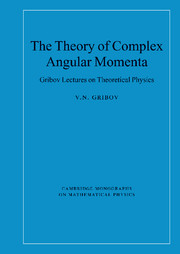Book contents
- Frontmatter
- Contents
- Foreword by Yuri Dokshitzer
- Introduction by Yuri Dokshitzer and Leonid Frankfurt
- 1 High energy hadron scattering
- 2 Physics of the t-channel and complex angular momenta
- 3 Singularities of partial waves and unitarity
- 4 Properties of Regge poles
- 5 Regge poles in high energy scattering
- 6 Scattering of particles with spin
- 7 Fermion Regge poles
- 8 Regge poles in perturbation theory
- 9 Reggeization of an electron
- 10 Vector field theory
- 11 Inconsistency of the Regge pole picture
- 12 Two-reggeon exchange and branch point singularities in the ℓ plane
- 13 Properties of Mandelstam branch singularities
- 14 Reggeon diagrams
- 15 Interacting reggeons
- 16 Reggeon field theory
- 17 The structure of weak and strong coupling solutions
- Appendix A Space-time description of the hadron interactions at high energies
- Appendix B Character of inclusive spectra and fluctuations produced in inelastic processes by multi-pomeron exchange
- Appendix C Theory of the heavy pomeron
- Index
9 - Reggeization of an electron
Published online by Cambridge University Press: 06 January 2010
- Frontmatter
- Contents
- Foreword by Yuri Dokshitzer
- Introduction by Yuri Dokshitzer and Leonid Frankfurt
- 1 High energy hadron scattering
- 2 Physics of the t-channel and complex angular momenta
- 3 Singularities of partial waves and unitarity
- 4 Properties of Regge poles
- 5 Regge poles in high energy scattering
- 6 Scattering of particles with spin
- 7 Fermion Regge poles
- 8 Regge poles in perturbation theory
- 9 Reggeization of an electron
- 10 Vector field theory
- 11 Inconsistency of the Regge pole picture
- 12 Two-reggeon exchange and branch point singularities in the ℓ plane
- 13 Properties of Mandelstam branch singularities
- 14 Reggeon diagrams
- 15 Interacting reggeons
- 16 Reggeon field theory
- 17 The structure of weak and strong coupling solutions
- Appendix A Space-time description of the hadron interactions at high energies
- Appendix B Character of inclusive spectra and fluctuations produced in inelastic processes by multi-pomeron exchange
- Appendix C Theory of the heavy pomeron
- Index
Summary
In this lecture we shall continue to consider the perturbation theory of quantum electrodynamics with a photon with a non-zero mass λ. The conventional QED with λ = 0 has its own specific features, which will be addressed later.
The reason for considering this theory and for accounting for all complications related to spin, is that in the field theory with vector mesons one may expect the appearance of Regge particles at small values of the coupling constant g. We note that although in the gφ3 theory there is a Regge pole, it is situated not near j = 0, which is required for reggeization of a scalar particle, but near j = − 1. From the point of view of Feynman diagrams this is related to the fact that in the t-channel with a fixed momentum transfer we had two particles instead of one in the Born pole diagram. Each additional line in the t-channel reduces the asymptotics of a diagram by one power of the large variable s. A compensation of this suppression is possible owing to the Azimov spin shifting, which is made manifest by the appearance of the factor sσ in the numerator of the Feynman amplitude, with σ the spin of the added particle. One can see from this that to make reggeization of a ‘nucleon’ possible in perturbation theory we should have a particle with σ = 1. Such a situation is realized in QED (see Fig. 9.1).
- Type
- Chapter
- Information
- The Theory of Complex Angular MomentaGribov Lectures on Theoretical Physics, pp. 112 - 120Publisher: Cambridge University PressPrint publication year: 2003

